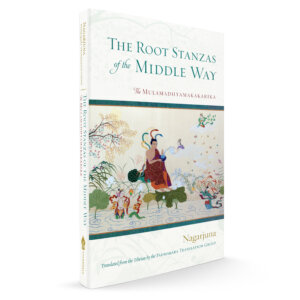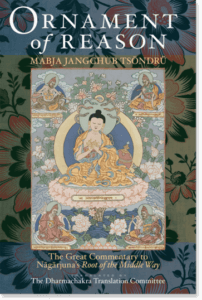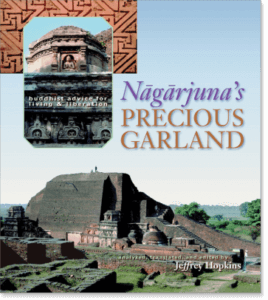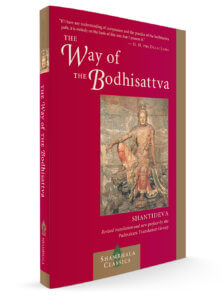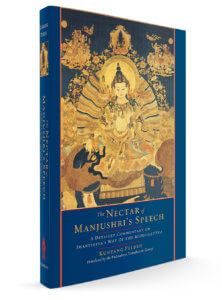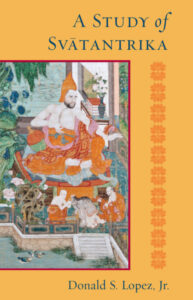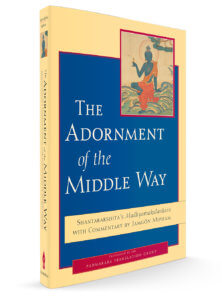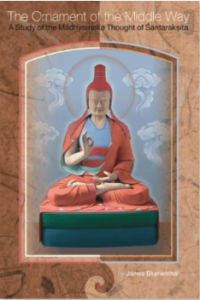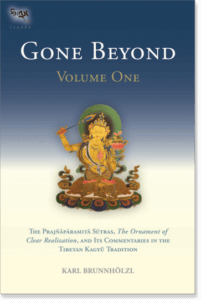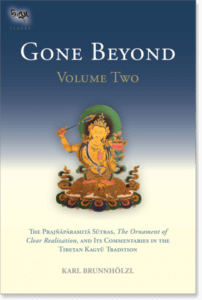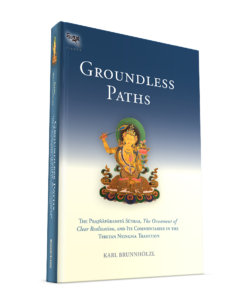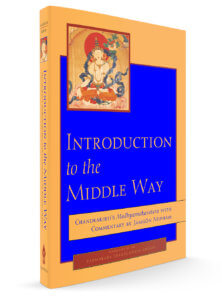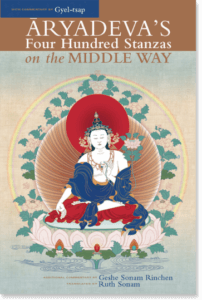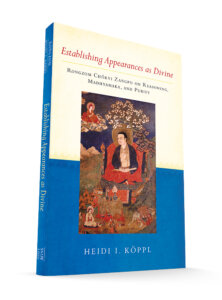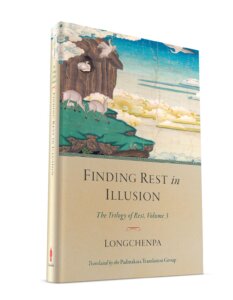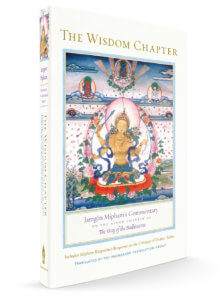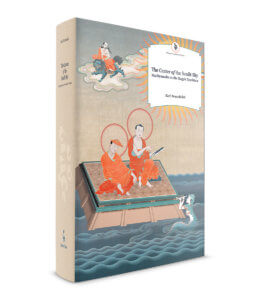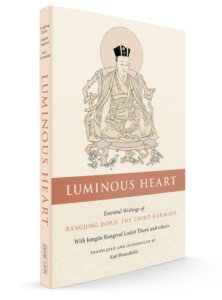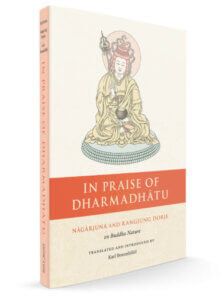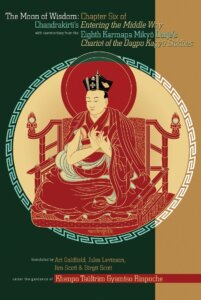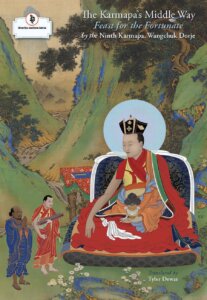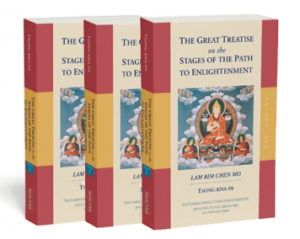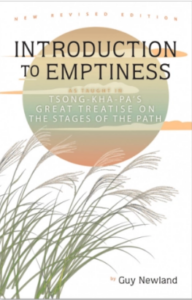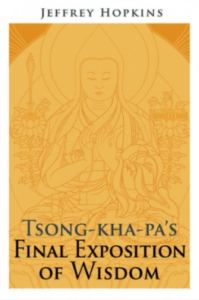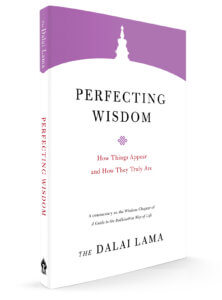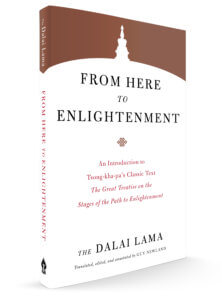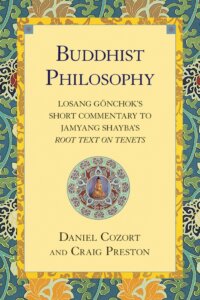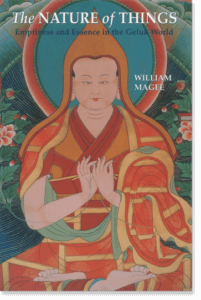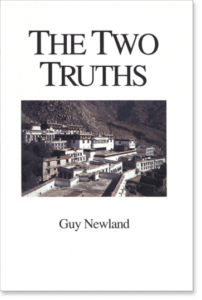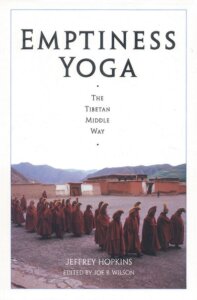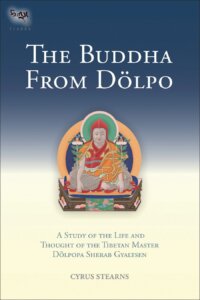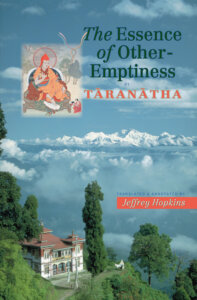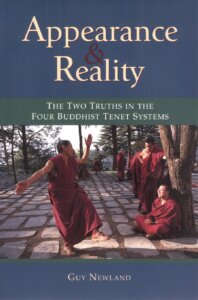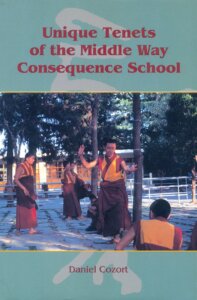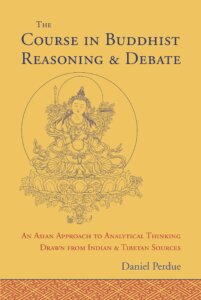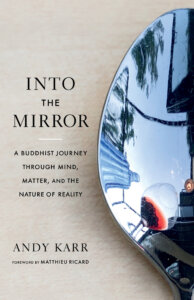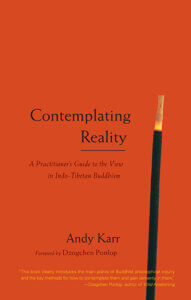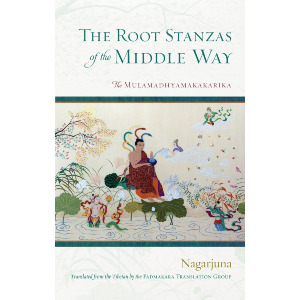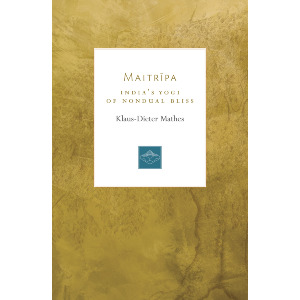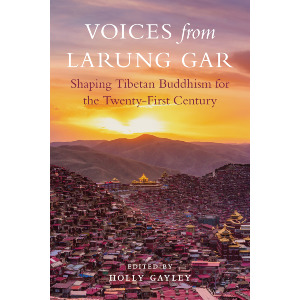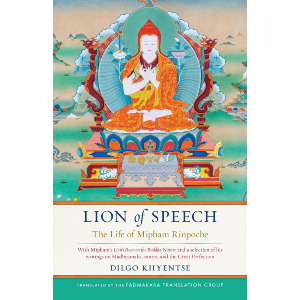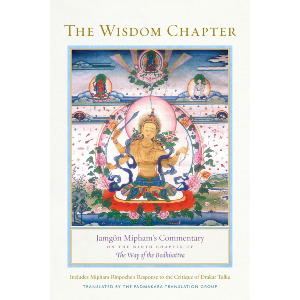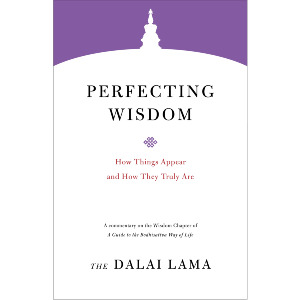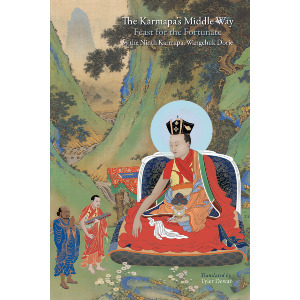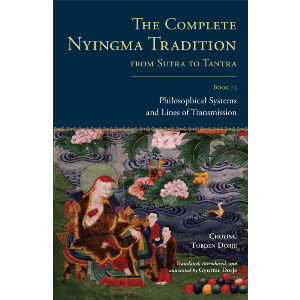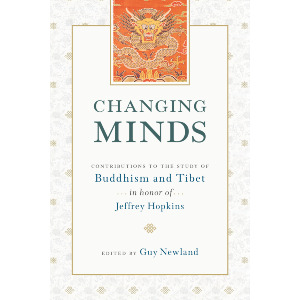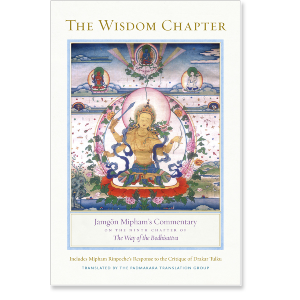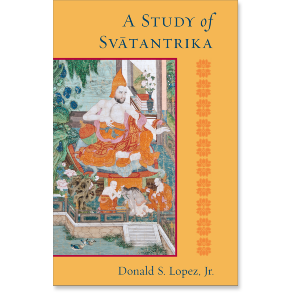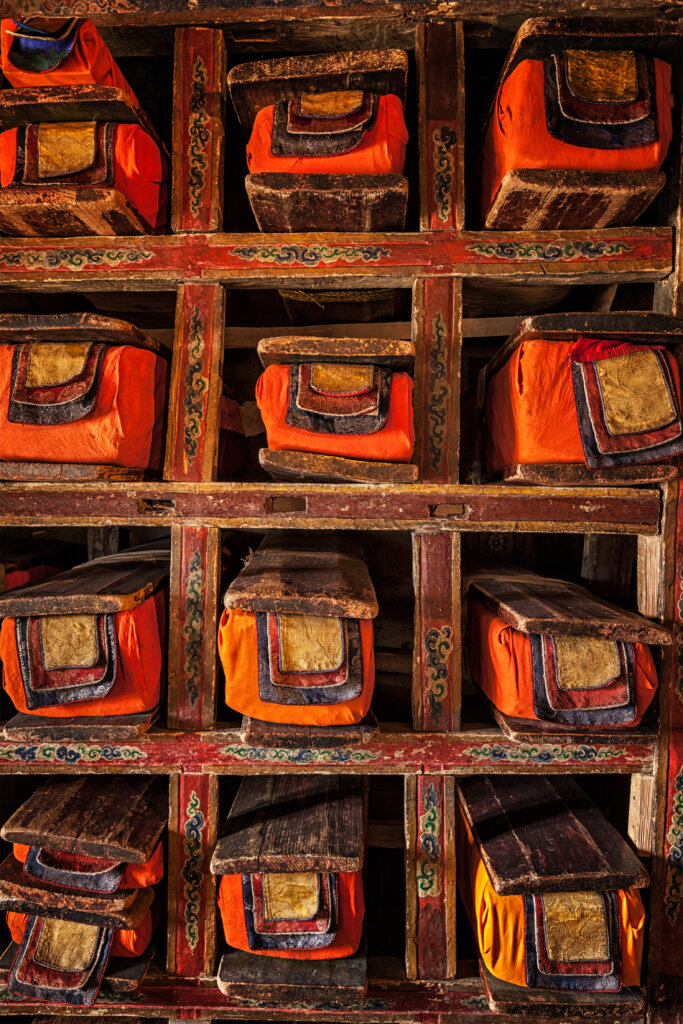
A Reader's Guide to Madhyamaka (The Middle Way)
Madhyamaka (Sanskrit) or Uma (Tibetan) is a system of Buddhist thought first articulated by the 2nd century Indian Buddhist master Nāgārjuna and elucidated further by subsequent Indian and Tibetan masters such as Chandrakirti, Shantideva, Aryadeva, Longchenpa, and Tsongkhapa, to name a few.
The premise of Madhyamaka is founded on the "doctrine of emptiness" or Shunyata beyond the extremes of existence, non-existence, both, or neither. According to proponents of Madhyamaka, all phenomena are empty of an intrinsic nature and lack autonomy in the sense that they are co-arisen with other phenomena. In other words, no "thing" can exist independently in and of itself. The nature of all things is empty of a solid intrinsic existence despite functioning in accordance with cause and effect. In that sense, the doctrine of emptiness is neither eternalistic or nihilistic. Hence, "emptiness beyond the extremes."
While Madhyamaka originated in India, it took on a vital position in Tibetan Buddhist doctrine among all schools of thought. Considered the pinnacle philosophical view by most schools of Tibetan Buddhism, Madhyamaka remains a central aspect of Tibetan discourse and can be found (or at least hinted toward) in everything from liturgical texts, philosophical doctrines, and even poetry.
Although the following guide for readers is not a comprehensive account of Madhyamaka found across all literary genres, it's meant to provide a springboard for discovering the vast range of books and media found here at Shambhala Publications.
Foundational Texts
The first selection of texts feature two of the most widely read authors across the schools of Tibetan Buddhism. Nāgārjuna, author of the famous Root Verses of the Middle Way, is considered the founder of Madhyamaka and is said to have brought the Prajñāparamitā, the principle sūtra on the Doctrine of Emptiness, into the world from an underwater Nāgā Kingdom. The second is the 8th century Indian master, Shantideva, known for his beloved text, The Way of the Bodhisattva.
The Root Stanzas of the Middle Way: The Mulamadhyamakakarika
By Nagarjuna
Translated by Padmakara Translation Group
The Root Stanzas holds a central place in all the Tibetan Buddhist traditions, as well as those in China, Japan, and Korea. It is prized for its arguments showing that things lack their “own nature,” and thus are “empty” (shunya) of inherent existence and abide in the middle way, free from the extremes of permanence and nihilism. Thus, Nagarjuna’s stanzas develop the seminal view of emptiness (shunyata) so crucial to understanding Buddhist philosophy and so central to its practice.
Ornament of Reason: The Great Commentary to Nagarjuna's Root of the Middle Way
By Mabja Jangchub Tsondru
Foreword by H.H. the Fourteenth Dalai Lama
Translated by Dharmachakra Translation Committee
The present work contains Nagarjuna's verses on the Middle Way accompanied by Mabja Jangchub Tsöndrü's famed commentary, the Ornament of Reason. Active in the twelfth century, Mabja was among the first Tibetans to rely on the works of the Indian master Candrakirti, and his account of the Middle Way exercised a deep and lasting influence on the development of Madhyamaka philosophy in all four schools of Buddhism in Tibet. Sharp, concise, and yet comprehensive, the Ornament of Reason has been cherished by generations of scholar-practitioners. The late Khunu Lama Tenzin Gyaltsen Rinpoche, a renowned authority on the subject, often referred to this commentary as "the best there is." A visual outline of the commentary has been added that clearly shows the structure of each chapter and makes the arguments easier to follow. Read More
Nagarjuna's Precious Garland: Buddhist Advice for Living and Liberation
By Nagarjuna
Translated by Jeffrey Hopkins
Nagarjuna is renowned for his penetrating analysis of reality. In the Precious Garland, he offers intimate counsel on how to conduct one's life and how to construct social policies that reflect Buddhist ideals. The advice for personal happiness is concerned first with improving one's condition over the course of lifetimes, and then with release from all kinds of suffering, culminating in Buddhahood. Nagarjuna describes the cause and effect sequences for the development of happiness within ordinary life, as well as the practices of wisdom, realizing emptiness, and compassion that lead to enlightenment. He describes a Buddha's qualities and offers encouraging advice on the effectiveness of practices that reveal the vast attributes of Buddhahood. In his advice on social and governmental policy, Nagarjuna emphasizes education and compassionate care for all living beings. He also objects to the death penalty. Calling for the appointment of government figures who are not seeking profit or fame, he advises that a selfish motivation will lead to misfortune. The book includes a detailed analysis of attachment to sensual objects as a preparation for realization of the profound truth that, when realized, makes attachment impossible.
The Way of the Bodhisattva
By Shantideva
Translated by Padmakara Translation Group
Treasured by Buddhists of all traditions, The Way of the Bodhisattva (Bodhicharyavatara) is a guide to cultivating the mind of enlightenment, and to generating the qualities of love, compassion, generosity, and patience. This text has been studied, practiced, and expounded upon in an unbroken tradition for centuries, first in India, and later in Tibet. Presented in the form of a personal meditation in verse, it outlines the path of the Bodhisattvas—those who renounce the peace of individual enlightenment and vow to work for the liberation of all beings and to attain buddhahood for their sake.
The Nectar of Manjushri's Speech: A Detailed Commentary on Shantideva's Way of the Bodhisattva
By Kunzang Pelden
Translated by Padmakara Translation Group
The Bodhicharyavatara, or Way of the Bodhisattva, composed by the eighth-century Indian master Shantideva, has occupied an important place in the Tibetan Buddhist tradition throughout its history. It is a guide to cultivating the mind of enlightenment through generating the qualities of love, compassion, generosity, and patience. In this commentary, Kunzang Pelden has compiled the pith instructions of his teacher Patrul Rinpoche, the celebrated author of The Words of My Perfect Teacher.
Svatantrika-Madhyamaka and Prasangika-Madhyamaka
Madhyamaka as an overarching school of thought covers a wide set of doctrinal subdivisions, the main two steams of thought being Svātantrika and Prāsangika. Svātantrika is attributed to the 6th century Indian scholar Bhāviveka who was later criticized by Buddhapalita for leaning too far into reasoning via syllogistic logic (svātantrika literally means "autonomous syllogistic reasoning") and overly conceptualizing the Doctrine of Emptiness. Prāsangika on the other hand is based on Candrakīrti's critique of Bhāviveka, in support of "logical consequence," ie., prāsangika, whereby phenomena are broken down to a point of non-essentialism (emptiness) through reasoning.
In Tibetan Buddhism, most schools hold Prāsangika as the pinnacle philosophical view point--a perspective which has not been without problems politically, socially, and philosophically speaking as we'll see below with the historical differences between the Geluk and Jonang tradition. Nonetheless, there are numerous texts and commentaries associated with both Svātantrika-Madhyamaka and Prāsangika Madhyamaka as we will see below.
A Study of Svatantrika
A Study of Svātantrika represents an important contribution to our understanding of Mādhyamika philosophy in India and Tibet. The Mādhyamika is considered to have two subschools, Svātantrika and Prāsangika. The Prāsangika school of Candrakīrti is better known than Svātantrika, in part because the major Svātantrika texts are preserved only in Tibetan translation. The Svātantrikas, however, made important contributions to Buddhist philosophy in their expositions of the nature of reality, the role of reasoning in the process of enlightenment, and in their delineations of the paths to nirvana. The synthesis of Yogācāra and Mādhyamika philosophy by the Svātantrika master Śāntaraksita represents the final development of Buddhist thought in India. In Tibet, Svātantrika was the first Indian Buddhist school to gain currency, prior to the translation of the works of Candrakīrti into Tibetan. Read More
Two Commentaries on Shantarakshita's Madhyamakalankara
Shantarakshita was an important Indian Buddhist philosopher known for introducing Madhyamaka and Yogācāra to Tibet as well as bringing the Indian tantric adept, Padmasambhava to Tibet in the 8th century CE. In terms of texts, he is widely remembered for his Madhyamakalankara, a text that combined Madhyamaka, Yogācāra and epistemology into a philosophical system known as Yogācāra-Svatantrika-Mādhyamaka or simply Yogācāra-Madhyamaka.
The following two texts include commentaries from two different schools of thought. The first from Mipham Rinpoche represents an interpretation from the Nyingma point of view and the second text represents the Geluk point of view.
The Adornment of the Middle Way: Shantarakshita's Madhyamakalankara with Commentary by Jamgon Mipham
Translated by Padmakara Translation Group
By Jamgon Mipham
By Shantarakshita
In the Madhyamakalankara, Shantarakshita synthesized the views of Madhyamaka and Yogachara, the two great streams of Mahayana Buddhism. This was the last great philosophical development of Buddhist India.
In his brilliant and searching commentary, Mipham re-presented Shantarakshita to a world that had largely forgotten him, defending his position and showing how it should be understood in relation to the teaching of Chandrakirti. To do this, he subtly reassessed the Svatantrika-Prasangika distinction, thereby clarifying and rehabilitating Yogachara-Madhyamaka as a bridge whereby the highest philosophical view on the sutra level flows naturally into the view of tantra. Mipham’s commentary has with reason been described as one of the most profound examinations of Madhyamaka ever written.
The Ornament of the Middle Way: A Study of the Madhyamaka Thought of Santaraksita
Shantarakshita's The Ornament of the Middle Way is among the most important Mahayana Buddhist philosophical treatises to emerge on the Indian subcontinent. In many respects, it represents the culmination of more than 1300 years of philosophical dialogue and inquiry since the time of the historical Buddha Shakyamuni. Shantarakshita set forth the foundation of a syncretic approach to contemporary ideas by synthesizing the three major trends in Indian Buddhist thought at the time (the Madhyamaka thought of Nagarjuna, the Yogachara thought of Asanga, and the logical and epistemological thought of Dharmakirti) into one consistent and coherent system. Shantarakshitas's text is considered to be the quintessential exposition or root text of the school of Buddhist philosophical thought known in Tibet as Yogachara-Svatantrika-Madhyamaka. In addition to examining his ideas in their Indian context, this study examines the way Shantarakshita's ideas have been understood by and have been an influence on Tibetan Buddhist traditions. Read More
"Gone Beyond" - The Prajñapāramitā Sutra and the Abhisamayālaṅkāra
The Prajñapāramitā Sūtra or Perfection of Wisdom is the principle corpus of Mahāyāna scriptures and the primary text associated with Madhyamaka. While texts such as the famous Heart Sutra (ie., the most condensed version of the Prajñapāramitā) emphasize the doctrine of emptiness, texts such as the Abhisamayālaṅkāra (Ornament of Realization) elaborate on the luminous nature described in the Prajñapāramitā.
In that regard, the following books by Karl Brunnhölzl are examples of Madhyamaka from a Yogācāra or Yogācāra-Svatantrika-Madhyamaka point of view.
Gone Beyond, Vol. 1: The Prajnaparamita Sutras, The Ornament of Clear Realization, and Its Commentaries in the Tibetan Kagyu Tradition
Translated by Karl Brunnhölzl
The first volume presents an English translation of the first three chapters of the Abhisamayalamkara and its commentary by the Fifth Shamarpa. Read More
Gone Beyond, Vol. 2: The Prajnaparamita Sutras, The Ornament of Clear Realization, and Its Commentaries in the Tibetan Kagyu Tradition
Translated by Karl Brunnhölzl
The second volume presents an English translation of the final five chapters and its commentary by the Fifth Shamarpa. Read More
Groundless Paths: The Prajnaparamita Sutras, The Ornament of Clear Realization, and Its Commentaries in the Tibetan Nyingma Tradition
Translated by Karl Brunnhölzl
Groundless Paths contains the first in-depth study of the Abhisamayalamkara (the text studied most extensively in higher Tibetan Buddhist education) and its commentaries from the perspective of the Nyingma School of Tibetan Buddhism. This study consists mainly of translations of Maitreya's famous text and two commentaries on it by Patrul Rinpoche. These are supplemented by three short texts on the paths and bhumis by the same author, as well as extensive excerpts from commentaries by six other Nyingma masters, including Mipham Rinpoche. Thus this book helps close a long-standing gap in the modern scholarship on the prajñaparamita sutras and the literature on paths and bhumis in mahayana Buddhism. Read More
Prasangika-Madhyamaka
The next selection of texts exemplify the philosophical point of view of Prasangika-Madhyamaka.
Introduction to the Middle Way: Chandrakirti's Madhyamakavatara with Commentary by Ju Mipham
By Jamgon Mipham
By Chandrakirti
Translated by Padmakara Translation Group
This book includes a verse translation of the Madhyamakavatara by the renowned seventh-century Indian master Chandrakirti, an extremely influential text of Mahayana Buddhism, followed by an exhaustive logical explanation of its meaning by the modern Tibetan master Jamgön Mipham, composed approximately twelve centuries later. Chandrakirti's work is an introduction to the Madhyamika teachings of Nagarjuna, which are themselves a systematization of the Prajnaparamita, or "Perfection of Wisdom" literature, the sutras on the crucial but elusive concept of emptiness.
Chandrakirti's work has been accepted throughout Tibetan Buddhism as the highest expression of the Buddhist view on the sutra level. With Jamgön Mipham's commentary, it is a definitive presentation of the wisdom of emptiness, a central theme of Buddhist teachings. This book is a core study text for both academic students and practitioners of Mahayana and Vajrayana Buddhism.
Aryadeva's Four Hundred Stanzas on the Middle Way: With Commentary by Gyel-tsap
By Aryadeva
By Gyel-tsap
By Geshe Sonam Rinchen
Translated by Ruth Sonam
Gyel-tsap Dar-ma-rin-chen states that Aryadeva's Four Hundred Stanzas was written to explain how, according to Nagarjuna, the practice of the stages of yogic deeds enables those with Mahayana motivation to attain Buddhahood. Both Nagarjuna and Aryadeva urge those who want to understand reality to induce direct experience of ultimate truth through philosophic inquiry and reasoning. Aryadeva's text is more than a commentary on Nagarjuna's Treatise on the Middle Way because it also explains the extensive paths associated with conventional truths. The Four Hundred Stanzas is one of the fundamental works of Mahayana Buddhist philosophy, and Gyel-tsap's commentary is arguably the most complete and important of the Tibetan commentaries on it. Read More
Madhyamaka in the Four Schools of Tibetan Buddhism
Just as there are two major streams of thought on Madhyamaka, each school and subdivision adheres to different modes of thought and practice. Below are a few examples of texts found in the Nyingma, Kagyu, Geluk, Sakya, and Jonang schools of Tibetan Buddhism
Madhyamaka and Dzogchen in the Nyingma School
Of all the texts from the Nyingma tradition, the following books by Rongzompa, Longchenpa, and Mipham, respectively, represent the Nyingma method of synthesizing Dzogchen and Madhyamaka through a scholar-practitioner modality. In the same light, these three Nyingma masters, Mipham Rinpoche in particular, are renowned for their work in systematizing philosophical thought in accordance with the Dzogchen point of view of the Nyingma.
Establishing Appearances as Divine: Rangzom Chokyi Zangpo on Reasoning, Madhyamaka, and Purity
By Heidi I. Koppl
By Rongzom Chokyi Zangpo
Establishing Appearances as Divine, a concise treatise by the eleventh-century Tibetan Buddhist philosopher Rongzom Chökyi Zangpo, sets out to prove the provocative point that everything that appears is actually deity manifest. Many books on Tibetan Buddhism address the important themes of mind training, compassion, and proper conduct, but this penetrating study and translation of Rongzom’s text goes beyond that in its aim to bring the reader face to face with his or her pure, divine nature.
Finding Rest in Illusion: The Trilogy of Rest, Volume 3
By Longchenpa
Translated by Padmakara Translation Group
This, the third volume of the Trilogy of Rest, introduces us to our most basic nature—the clear and pristine awareness that is the nature of the mind. The Padmakara Translation Group has provided us with a clear and fluid new translation of the final volume, Finding Rest in Illusion, along with its autocommentary, The Chariot of Excellence, which describes in detail the conduct of those who have stabilized their recognition of the nature of the mind and how to apply the Buddhist view when relating to ordinary appearances. This is an invaluable manual for any genuine student of Buddhism who wishes to truly find rest through the path of the Great Perfection.
The Wisdom Chapter: Jamgön Mipham's Commentary on the Ninth Chapter of The Way of the Bodhisattva
Shāntideva’s guide to the training of a Bodhisattva is one of the most important and beloved texts in the Tibetan tradition. The ninth chapter, however, dealing with Madhyamaka, the Middle Way, the most profound wisdom view of Mahayana Buddhism, has always posed unique challenges to readers. This commentary by the great scholar Mipham Rinpoche presents in quite straightforward terms Shāntideva’s exposition of emptiness, the essential foundation of all Buddhist doctrine, demonstrating that it is not only compatible with, but in fact crucial to, the correct understanding of other important Buddhist teachings such as karma, rebirth, and the practice of compassion. Mipham interprets Shāntideva according to the view of the Nyingma school, which in some respects was at variance with the religiously and politically dominant interpretation of the text in Tibet at that time. As a result, his commentary stirred up a furious debate. With the addition of a critique of Mipham Rinpoche’s view by a prominent scholar of the time, along with Mipham’s response, that debate is beautifully captured in this volume.
Madhyamaka and Mahamudra in the Kagyu Tradition
Similar to the Nyingma approach to Madhyamaka, the Kagyu School emphasizes the integration of Madhyamaka with their pinnacle approach: Mahamudra. Marked by an emphasis on the luminous qualities of mind, the following texts represent some of the most widely renowned thinkers from the Kagyu School and the Mahamudra point of view and practice including The Third Karmapa Rangjung Dorje, The Eight Karmapa Mikyo Dorje, and The Ninth Karmapa Wangchuk Dorje.
The Center of the Sunlit Sky: Madhyamaka in the Kagyu Tradition
Madhyamaka is a potent and universally accessible means of calming our suffering and awakening to our innate wisdom. The Center of the Sunlit Sky artfully rescues this brilliant teaching from its unwarranted reputation for intellectual opacity and reinstates it as a supremely practical tool kit for everyday living. The aim of this book is to take Madhyamaka out of the purely intellectual corner into which it unjustly gets boxed. It is an attempt to show how Madhayamaka actually addresses and works with all of our experiences in life.
The book follows the original Indian sources as well as the standard commentaries on Madhyamaka in the Kagyu School of Tibetan Buddhism. At the same time, these materials are adapted for a contemporary audience, combining the familiar sharpness of Madhyamaka reasonings (launching a massive assault on our cherished belief systems) with exploring the practical relevance of the Madhyamaka way of mind training.
Luminous Heart: Essential Writings of Rangjung Dorje, the Third Karmapa
By The Third Karmapa
By Jamgon Kongtrul Lodro Taye
Translated by Karl Brunnhölzl
This extraordinary collection of writings on buddha nature by the Third Karmapa Rangjung Dorje (1284–1339) focuses on the transition from ordinary deluded consciousness to enlightened wisdom, the characteristics of buddhahood, and a buddha’s enlightened activity. The Third Karmapa’s unique and balanced view synthesizes Yogacara Madhyamaka and the classical teachings on buddha nature. Included are commentaries by Jamgön Kongtrul Lodrö Tayé that supplement the view of the Third Karmapa on two fundamental treatises on buddha nature, emphasizing the luminous empty mind of buddha nature as presented by the great Indian masters Maitreya and Asaṅga. For those practicing the sutrayāna and the vajrayāna in the Kagyü tradition, what these texts describe can be transformed into living experience.
In Praise of Dharmadhatu: Nagarjuna and Rangjung Dorje on Buddha Nature
By Nagarjuna
Translated by Karl Brunnhölzl
By Rangjung Dorje
Nāgārjuna's works sit at the heart of Mahāyāna Buddhist thought and practice, but he was renowned in Asia not only for his Madhyamaka work, but also his poetic collection of praises, most famously In Praise of Dharmadhatu. This book explores the scope, contents, and significance of Nāgārjuna’s scriptural legacy in India and Tibet, focusing primarily on this seminal work. The translation of Nāgārjuna’s hymn to buddha nature—here called dharmadhatu—shows how buddha nature is temporarily obscured in the experience of ordinary sentient beings, gradually uncovered through the path of bodhisattvas, and finally revealed in full bloom as buddhahood. Included is a translation of the text’s earliest and most extensive commentary by the Third Karmapa, Rangjung Dorje (1284–1339), supplemented by relevant excerpts from all other available commentaries.
The Moon of Wisdom
By Chandrakirti
By The Eighth Karmapa Mikyo Dorje
Translated by Ari Goldfield
Translated by Jules B. Levinson
Translated by Jim Scott
Translated by Birgit Scott
Translated by Khenpo Tsultrim Gyamtso
Nagarjuna, in his seminal text, The Fundamental Wisdom of the Middle Way, summarized the vast teachings of the Buddha and used logical reasoning to prove the validity of his words. Entering the Middle Way is Chandrakirti's explanation of Nagarjuna's work. Its sixth chapter, which comprises the majority of the text, has four main sections: an explanation of how in genuine reality phenomena do not truly arise; a refutation of the Mind-Only School's assertion that mind truly exists; a refutation of the true existence of the personal self; and an explanation of the sixteen emptinesses taught by"the Buddha in the Transcendent Wisdom Sutras. The Moon of Wisdom is thus a book that explains the Buddha's ultimate teachings, how to gain confidence in them, and how to put them into practice in one's"own life to the great benefit of oneself and others.
The Karmapa's Middle Way: Feast for the Fortunate
By The Ninth Karmapa Wangchuk Dorje
Translated by Tyler Dewar
Marked by eloquent poetry, vigorous and extensive analysis, and heart instructions on breaking through the veils of confusion to independently experience the true nature of things, The Karmapa’s Middle Way contains the Ninth Karmapa Wangchuk Dorje’s comprehensive commentary on the Indian master Chandrakīrti’s seminal text, the Madhyamakāvatāra, or Entrance to the Middle Way. This commentary, Feast for the Fortunate, is the Ninth Karmapa’s abridgement of the Eighth Karmapa Mikyö Dorje’s masterpiece, the Chariot of the Takpo Kagyü Siddhas. In it, readers will find previously unavailable material on the Karmapas’ Middle Way view and a rare window into a philosophically charged era of Middle Way exposition in Tibetan Buddhism. It includes Chandrakīrti’s root text to the Entrance to the Middle Way and its commentary by the Ninth Karmapa; an introduction detailing the history of the Middle Way, key Middle Way philosophical principles, and the main points of each chapter of the text; an annotated translation of a famous excerpt of Chandrakīrti’s Lucid Words; and other useful appendices and reference materials.
Madhyamaka and Self-Emptiness (rang tong) in the Gelug Tradition
The Gelug tradition, founded by Je Tsongkhapa (1357-1419), emphasizes an understanding of Prasangika Madhyamaka maintaining a view called rang tong (self-empty) as opposed to shen tong (other-empty). In short, both schools agree that relative reality is empty of inherent nature. However, rang tong argues that all phenomena are empty of an enduring "self" and that emptiness does not entail an absolute reality. On the other hand, shen tong emphasizes a non-dual absolute reality.
Below is a selection of books on Madhyamaka from the Gelug tradition including select books from His Holiness the Dalai Lama, the current head of the Gelug school. To learn more, check out our Gelug category page.
Tsongkhapa's Great Treatise on the Stages of the Path to Enlightenment
First and foremost among texts from the Gelug tradition is Tsongkhapa's Great Treatise, a three volume collection that condenses sutric scriptures into an authoritative manual.
More about this collection:
The Great Treatise on the Stages of the Path to Enlightenment (Tib. Lam rim chen mo) is one of the brightest jewels in the world’s treasury of sacred literature. The author, Tsong-kha-pa, completed it in 1402, and it soon became one of the most renowned works of spiritual practice and philosophy in the world of Tibetan Buddhism. Because it condenses all the exoteric sūtra scriptures into a meditation manual that is easy to understand, scholars and practitioners rely on its authoritative presentation as a gateway that leads to a full understanding of the Buddha’s teachings.
Tsong-kha-pa took great pains to base his insights on classical Indian Buddhist literature, illustrating his points with classical citations as well as with sayings of the masters of the earlier Kadampa tradition. In this way the text demonstrates clearly how Tibetan Buddhism carefully preserved and developed the Indian Buddhist traditions.
Introduction to Emptiness: As Taught in Tsong-kha-pa's Great Treatise on the Stages of the Path
By Guy Newland
Readers are hard-pressed to find books that can help them understand the central concept in Mahayana Buddhism—the idea that ultimate reality is emptiness. In clear language, Introduction to Emptiness explains that emptiness is not a mystical sort of nothingness, but a specific truth that can and must be understood through calm and careful reflection. Newland's contemporary examples and vivid anecdotes will help readers understand this core concept as presented in one of the great classic texts of the Tibetan tradition, Tsong-kha-pa's Great Treatise on the Stages of the Path to Enlightenment. This new edition includes quintessential points for each chapter.
Tsong-kha-pa's Final Exposition of Wisdom
This book first presents the final exposition of special insight by Tsong-kha-pa, the founder of the Ge-luk-pa order of Tibetan Buddhism, in his medium-length Exposition of the Stages of the Path as well as the sections on the object of negation and on the two truths in his Illumination of the Thought: Extensive Explanation of Chandrakirti's Supplement to Nagarjuna's "Treatise on the Middle." It then details the views of his predecessor Dol-po-pa Shay-rap Gyel-tsen, the seminal author of philosophical treatises of the Jo-nang-pa order, as found in his Mountain Doctrine, followed by an analysis of Tsong-kha-pa's reactions. By contrasting the two systems—Dol-po-pa's doctrine of other-emptiness and Tsong-kha-pa's doctrine of self-emptiness—both views emerge more clearly, contributing to a fuller picture of reality as viewed in Tibetan Buddhism. Tsong-kha-pa's Final Exposition of Wisdom brilliantly explicates ignorance and wisdom, explains the relationship between dependent-arising and emptiness, shows how to meditate on emptiness, and explains what it means to view phenomena as like illusions. Read More
Books from His Holiness the 14th Dalai Lama - the Head of the Geulg school
The following books are commentaries from HHDL on two classic texts. The first of which is a commentary on the previously mentioned Great Treatise by Tsongkhapa and the second is a commentary on the Wisdom Chapter from The Way of the Bodhisattva (also mentioned above).
Perfecting Wisdom: How Things Appear and How They Truly Are
By H.H. the Fourteenth Dalai Lama
This extraordinarily clear exposition on the wisdom section of A Guide to the Bodhisattva Way of Life is based on an oral teaching given in Switzerland by H.H. the Dalai Lama before an audience of thousands of Tibetans and Westerners in 1979. Shantideva’s A Guide to the Bodhisattva Way of Life is one of the most important texts in the Mahayana tradition of Buddhist practice. Its ninth chapter, the section on transcendent wisdom, is known among Buddhist scholars as a challenging exposition of Madhyamika philosophy and difficult to understand without a commentary. This invaluable volume with its precise elucidation of the core issues of Tibetan Buddhism stands as a key work in Buddhist literature.
From Here to Enlightenment: An Introduction to Tsong-kha-pa's Classic Text The Great Treatise on the Stages of the Path to Enlightenment
By H.H. the Fourteenth Dalai Lama
Translated by Guy Newland
When the Dalai Lama was forced into exile in 1959, he could take only a few items with him. Among these cherished belongings was his copy of Tsong-kha-pa’s classic text The Great Treatise on the Stages of the Path to Enlightenment. This text distills all the essential points of Tibetan Buddhism, clearly unfolding the entire Buddhist path.
In 2008, celebrating the long-awaited completion of the English translation of the Great Treatise, the Dalai Lama gave a historic six-day teaching at Lehigh University to explain the meaning of the text and underscore its importance. It is the longest teaching he has ever given to Westerners on just one text—and the most comprehensive. From Here to Enlightenment makes the teachings from this momentous event available for a wider audience.
Additional Commentaries from the Tradition
Buddhist Philosophy: Losang Gonchok's Short Commentary to Jamyang Shayba's Root Text on Tenets
By Daniel Cozort
By Craig Preston
What are the most important points of difference between the major schools of Buddhist philosophy? This rich, medium-length survey offers a lively answer. The introduction, aimed at those new to Buddhist thought, sets up a dialogue between the schools on the most controversial topics in Buddhist philosophy. Jamyang Shayba was the greatest Tibetan writer on philosophical tenets. Losang Gonchok's Clear Crystal Mirror, a concise commentary on Jamyang Shayba's root text, represents a distillation of many centuries of Indian and Tibetan scholarship. Buddhist Philosophy skims the cream of Jamyang Shayba's intellect, providing a rare opportunity to sharpen our intellect and expand our view of Buddhist thought.
How to Realize Emptiness
By Gen Lamrimpa
Edited by Ellen Posman
Translated by B. Alan Wallace
Realizing emptiness or grasping the true nature of reality lies at the heart of the Buddhist path. In this book, Gen Lamrimpa offers practical instruction on Madhyamaka, insight meditation aimed at realizing emptiness. Drawing on his theoretical training as well as his extensive meditative experience, he explains how to use Madhyamaka reasoning to experience the way in which all things exist as dependently related events.
Other Commentaries from Western Scholars
The Nature of Things: Emptiness and Essence in the Geluk World
Nature is a topic in many Indian and Tibetan philosophical texts, although its meaning varies considerably in both Hindu and Buddhist scriptures. The discussion of nature pursued in this book begins with Nagarjuna (first century), founder of the Middle Way School, who refuted a fabricated nature in his Treatise on the Middle. In that seminal text, he puts forth the three basic criteria for nature: it must be something that is non-fabricated, independent, and immutable.
This book presents Dzong-ka-ba's discussion of the overly narrow object in his Great Exposition and relates that discussion to Nagarjuna's verses in Treatise on the Middle. When combined with an understanding of an overly broad object to be negated, this topic brings the Middle Way practitioner to a precise identification of the nonexistent object-of-negation nature as being a thing's establishment by way of its own entity.
This book also presents Dzong-ka-ba's more mainstream commentary on the subject in the Ocean of Reasoning sections, which are translated in Part Two. It also describes Dzong-ka-ba's strong reaction to the positive and independent nature asserted by Tibet's greatest synthesist, Dol-bo Shay-rap-gyel-tsen (fourteenth century).
The Two Truths
By Guy Newland
The persistent problem of Buddhist philosophy has been to find the middle way—an ontology sturdy enough to support a coherent ethical system that does not betray Buddha's original vision of no-self or emptiness (sunyata). Buddhist perspectives on ethics and emptiness center on the distinction between two truths—the conventional and the ultimate. Newland's work lays out the Madhyamika philosophy of two truths as seen through the eyes of Tibetan scholar-yogis of the Gelugpa order. Linking the classical Buddhist philosophy of Nagarjuna with the living tradition of monastic courtyard debate, the authors explain the two truths without resort to mysterious trans-rational paradoxes. Newland exposes their extraordinary efforts to clear away the sense of contradiction between emptiness and conventional reality and thus to build a Madhyamika system that is both ethically salutary and rationally coherent.
Emptiness Yoga: The Tibetan Middle Way
By Jeffrey Hopkins
Edited by Joe B. Wilson
An absorbing exposition of the methods of realization of the Middle Way Consequence School (Prasangika Madhyamika) by Jeffrey Hopkins—considered by many the foremost Western authority on Tibetan Buddhism. His presentation is based on Jang-gya's famous work—the original and translation are included. The reasonings used to analyze persons and phenomena to establish their true mode of existence are discussed in the context of meditative practice. This exposition includes a masterful treatment of the compatibility of emptiness and dependent-arising.
Madhyamaka and Other-Emptiness (shen tong) in the Jonang Tradition
As mentioned above, shen tong, or "other emptiness," refers to a view of a non-dual yet "truly existing" absolute reality as opposed to a complete negation. Shen tong was first articulated by the founder of the Jonang school, Dolpopa Sherab Gyaltsen whose biography can be found below in addition to other books from the Jonang tradition here at Shambhala Publications.
The Buddha from Dolpo: A Study in the Life and Thought of the Tibetan Master Dolpopa Sherab Gyaltsen
The Buddha from Dölpo is a revised and enlarged edition of the only book about the most controversial Buddhist master in the history of Tibet, Dölpopa Sherab Gyaltsen (1292–1361), who became perhaps the greatest Tibetan expert of the Kalacakra or Wheel of Time, a vast system of tantric teachings. Based largely on esoteric Buddhist knowledge from the legendary land of Shambhala, Dölpopa's insights have profoundly influenced the development of Tibetan Buddhism for more than 650 years. Dölpopa emphasized two contrasting definitions of the Buddhist theory of emptiness. He described relative phenomena as empty of self-nature, but absolute reality as only empty of other (i.e. relative) phenomena. He further identified absolute reality as the buddha nature or eternal essence present in all living beings. This view of an "emptiness of other," known in Tibetan as shentong, is Dölpopa's enduring legacy. The Buddha from Dölpo contains the only English translations of three of Dölpopa's crucial works. A General Commentary on the Doctrine is one of the earliest texts in which he systematically presented his view of the entire Buddhist path to enlightenment. The Fourth Council and its Autocommentary (which was not in the first edition of this book) were written at the end of his life and represent a final summation of his teachings. These translations are preceded by a detailed discussion of Dölpopa's life, his revolutionary ideas, earlier precedents for the shentong view, his unique use of language, and the influence of his theories. The fate of his Jonang tradition, which was censored by the central Tibetan government in the seventeenth century but still survives, is also examined.
The Essence of Other-Emptiness
By Taranatha
Translated by Jeffrey Hopkins
Translated by Lama Lodro Namgyel
Jeffrey Hopkins continues his groundbreaking exploration of the Jo-nang-ba sect of Tibetan Buddhism with this revelatory translation of one of the seminal texts from that tradition. Whereas Dol-bo-ba's massive Mountain Doctrine authenticates the doctrine of other-emptiness through extensive scriptural citations and elaborate philosophical arguments, Taranatha's more concise work translated here situates the doctrine of other-emptiness within the context of schools of tenets, primarily the famed four schools of Tibetan Buddhism, through comparing the various schools' opinions on the status of the noumenon and phenomena. Also included is a supplementary text by Taranatha which presents the opinions of a prominent fifteenth-century Sakya scholar, Shakya Chok-den, and contrasts them with those of the leading Jo-nang-ba scholar Dol-bo-ba.
Madhyamaka and the Four Buddhist Tenet Systems
The concept of Buddhist tenet systems carried over from Indian to Tibetan Buddhism and continues to influence Tibetan Buddhist philosophy and practice. While there are numerous schools of Buddhist thought, the four major tenet systems are, Vaibhashika, Sautantrika, Chittamatra, and Madhyamaka, with Madhyamaka believed to be the most refined philosophical view point.
The following books introduce the topic of the Four Buddhist Tenet Systems and provide more context for how and why Madhyamaka is so relevant to Tibetan Buddhist philosophy and practice.
Appearance and Reality: The Two Truths in the Four Buddhist Tenet Systems
By Guy Newland
When someone seeks to understand Buddhism, where should that person start? With the meaning of taking refuge in the three jewels? With the four noble truths? The Dalai Lama, when asked this question, suggested that for many in the West today, understanding the two truths—conventional truth and ultimate truth—is the best place to start.
When the Buddha awoke from the dream we still dream, he saw the ultimate reality of things just as they are. There are shifting appearances and conventions, the manners and traditions of the vast and diverse world; and then there is the mystery of the sheer reality of things. And yet we cannot find this reality anywhere else but right here.
Each system of Buddhist philosophy has its own way of explaining exactly what these two truths are and how they relate to one another. In exploring these systems, we are looking over the shoulders of Buddhist thinkers as they grapple with a basic question: 'What is real?' This is not an idle intellectual exercise but a matter which cuts to the heart of our practice in life.
Unique Tenets of the Middle Way Consequence School
According to Tibetan traditions, the Indian Buddhist Prasangika-Madhyamika school is the one that represents the final true thought of the Buddha. Unique Tenets of the Middle Way Consequence School presents and analyzes the issues that separate that school from the other principals schools of Buddhism—issues such as the existence (or non-existence) of an external world the way in which karma and reincarnation operate the nature of consciousness the nature of time and the status of Arhats (enlightened but not omniscient beings). Parts Two and Three of the book are annotated translations of Tibetan texts that are used as source books in monastic education.
The Course in Buddhist Reasoning and Debate: An Asian Approach to Analytical Thinking Drawn from Indian and Tibetan Sources
Buddhism is a wisdom tradition. It asserts that we are liberated by the power of our own understanding. The three purposes of Buddhist debate are to defeat your own and others’ misconceptions, to establish your own correct view, and to clear away objections to your view. It is like the approach of a physician—to remove what does not belong and to strengthen what does. Thus, for Buddhists, reasoning and debate are not ends in themselves or idle intellectual speculation. Rather, they are used as one path to spiritual wellness, taking practitioners closer to the health of liberation through these efforts to remove mistaken views and to understand and strengthen correct ones. Read More
Western View Points and Commentaries on Madhyamaka
Madhyamka remains a subject of interest not only among Tibetan Buddhist scholars and practitioners, but also in the academic field. The following are a few examples of books on Madhyamaka from a western perspective.
Into the Mirror: A Buddhist Journey through Mind, Matter, and the Nature of Reality
By Andy Karr
Into the Mirror is a call to cultivate wisdom and compassion—right within this world of illusion—and an insightful challenge to the rampant materialism of modernity. Andy Karr presents accessible and powerful methods to accomplish this through investigating the way our minds construct our worlds.
Combining contemporary Western inquiries with classical Buddhist investigations into the nature of mind, Karr invites the reader to make a personal, experiential journey through study, contemplation, and meditation. He presents a series of contemplative practices from Mahayana Buddhism, starting with the Middle Way teachings on emptiness and interdependence, through Yogachara’s subtle understanding of nonduality, to the view that buddha nature is already within us to be revealed rather than something external to be acquired.
Contemplating Reality: A Practitioner's Guide to the View in Indo-Tibetan Buddhism
By Andy Karr
This book is for intermediate and advanced Buddhist practitioners who wish to deepen their understanding by joining practice with study of traditional ideas. It introduces the reader to contemplations that investigate a series of views of reality as they evolved in the Buddhist tradition. These views are explained in plain English, with contemporary metaphors and examples to bring out their meaning for modern Buddhists. Quotations from both historical and living meditation masters and scholars are presented as examples of key principles. Topics include: egolessness, pppearances and reality, methods of investigation, enlightenment, tenets of different schools through the centuries, the root of compassion, and the origin of thoughts.
Guided exercises encourage the reader to trust in experiential understanding through deep contemplation of complex concepts. The book is structured as a guide for the reader’s journey.


